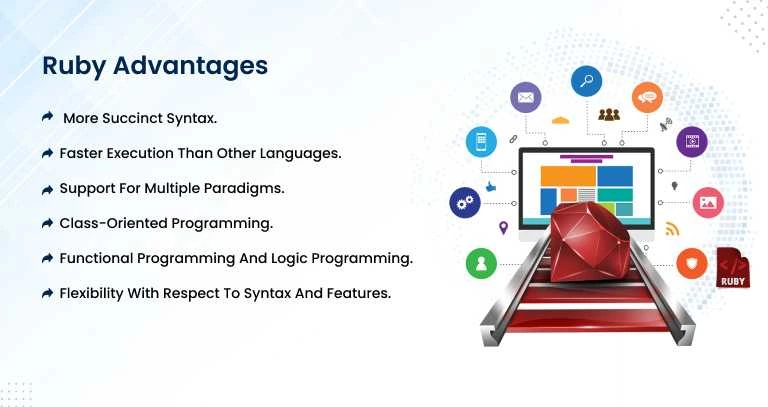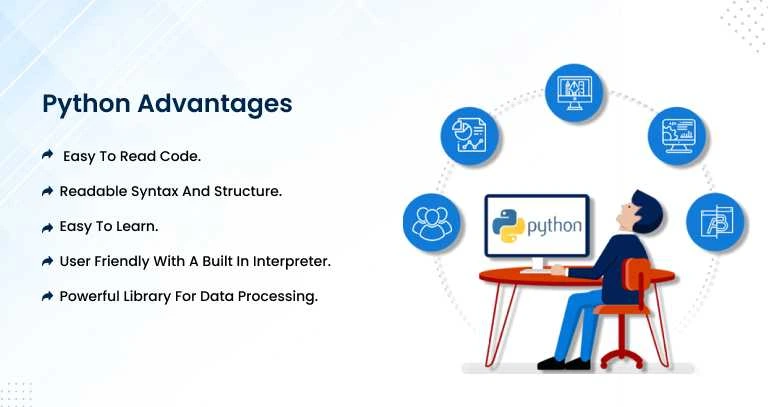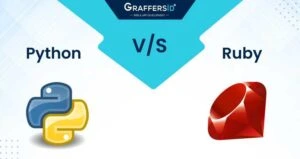Programming languages are the backbone of software development, and choosing the right one for your project can be a daunting task. Two languages that have gained a significant following over the years are Python and Ruby. Both languages are known for their simplicity, readability, and versatility, making them popular choices for building web applications, data analysis, machine learning, and more. But which one should you choose for your project in 2025? In this blog post, we will dive deep into the differences between Python vs Ruby and help you make an informed decision. So, whether you’re a beginner or an experienced developer, read on to find out which language is best suited for your needs.
What is Ruby?
Ruby on Rails programming language is one of the most popular programming languages and is used to build websites. It is often compared to languages like JavaScript, Python, or PHP and it has a lot of similarities with Python. Ruby on Rails was designed with an emphasis on simplicity, power, and readability. It can be used for all types of programmers, but mostly for web applications and as a backend scripting language. The syntax is based on English, which makes it easy to follow and use. It also has very good libraries that make it a great choice for programmers with limited time.
What Is Python?
Python is a powerful, flexible, and popular programming language. Python’s design makes it easy to learn and use.
Python has been around since 1991 and it was conceived by a Dutch programmer. It is an interpreted high-level programming language with an emphasis on readability nurtured by the designer of the language – Guido van Rossum. The interpreter itself is open source and has been released under the GNU General Public Licence as well as a 3-Clause BSD License (Python License).
Python provides efficient high-level data structures and supports dynamic typing, making it a popular choice for scripting languages in numerous fields such as system administration, web development, finance, and games.
Ruby Features
Ruby is a programming language that was designed to be easy to learn. Nowadays, Ruby is on the list of the best programming languages.
Object-Oriented Programming:
The object-oriented programming language Ruby is a dynamic, reflective, general-purpose object-oriented programming language. It was designed and developed by Yukihiro Matz Matsumoto in the late 1990s.
The motivation behind Ruby was to create a new language that was easy to learn and use. It simplifies many of the complexities of more traditional languages like C++ or Java by removing unnecessary syntax and simplifying rules.
Provides Dynamic Language:
The most important difference between Ruby and any other language is that Ruby is dynamic. Dynamic languages require less rigid programming and don’t always require a programmer to define specific data types beforehand. Data types are passed at runtime without the need for a programmer to define them beforehand. This helps to speed up the development process. Dynamic languages offer you more flexibility and are typically easier to program.
Simplifies Complexity:
Ruby is a general-purpose programming language that lets developers build web applications easily. Ruby simplifies complexity with its syntax, which is easy to learn and read. It’s ruby’s simplicity that makes it an ideal language for beginners. It also simplifies development, because Ruby is a versatile language that can be applied to many different types of projects.
Visual appearance:
The visual appearance of Ruby is a major factor in what makes it so easy to learn. It has a syntax that is straightforward and easy to read, with minimal punctuation and characters. Visual Appearance of the language includes:
- Highlighting for errors
- The Rubies Toolkit
- Syntax Highlighting
- Flexibility
- Interpreted Language
Advantages of Ruby

Ruby is a dynamic, object-oriented, general-purpose programming language. It was created by Yukihiro “Matz” Matsumoto in the 1990s. The goal of the Ruby programming language is to make programmers more productive.
There are many benefits of using Ruby programming language:
- More succinct syntax.
- Faster execution than other languages.
- Support for multiple paradigms of object-oriented programming.
- Class-oriented programming.
- Functional programming and logic programming.
- Flexibility with respect to syntax and features.
- It produces code that executes efficiently.
- Its small size enables developers to create applications quickly.
Disadvantages of Ruby
Ruby is a popular programming language for web application developers. It was designed to be a lightweight, interpreted, and object-oriented language.
The Ruby Disadvantages are:
- Ruby has no native cross-platform support, meaning that native code that you write for one platform won’t work on another platform so you can only use the same libraries on each platform.
- Ruby is not very suitable for multithreaded tasks, because of this it can’t be used to efficiently run massively parallel computing workloads like high-performance computing or data science applications.
- Ruby has no way of catching errors at runtime so instead, it uses exception handling which will crash the program generating an error message.
Python Features:
Python is a general-purpose programming language. The features it offers make it a flexible and powerful choice for data analysis and machine learning.
Python is an open-source programming language that lets developers build just about anything they can imagine, from apps to games to web services.
The following are some of the features that Python offers:
- User-friendly, easy to learn
- High level of support for mathematics and data structuring
- Flexible syntax
- Wide variety of libraries for tasks such as data analysis, machine learning, and web development
- A virtual environment that makes it easier to work with multiple projects at the same time
Advantages of Python:

Python, a high-level programming language, is one of the most popular programming languages in the world. It has an extensive and powerful library for data processing and analysis.
The Advantages of Python languages are:
- Easy to read code.
- Readable syntax and structure.
- Easy to learn.
- User-friendly with a built-in interpreter.
- Powerful library for data processing.
Disadvantages of Python
Python is a widely used programming language, but it doesn’t mean that it is without disadvantages. It can also be an issue for developers at times.
- The learning curve can be steep;
- It has a relatively small number of available libraries;
- Certain tasks such as installing packages can be difficult because they are not managed by an open-source package manager like pip; and
- The language may not be expressive enough for some programmers who want their code to flow in a way that looks similar to human languages like
- The syntax may not be as easy for beginners to learn.
- No automatic memory management: You need to manage the memory by yourself which can be troublesome when you got a large amount of data (For example, when you calculate a list of numbers).
- Lack of performance in case there are no optimizations made.
Similarities Between Ruby And Python
Python and Ruby are both object-oriented programming languages with a lot of similarities that make them comparable.
One similarity between Python and Ruby is their syntax. Python and Ruby are considered to have fairly easy syntax that doesn’t get in the way of their usability.
Another similarity is the number of platforms where they can be used. Python can be used on virtually every platform out there, as it has been ported to run on Windows OS, OS X, Linux, Unix, and more. Similarly, Ruby can be used on Windows OS, Linux, and Unix systems too.
Python vs Ruby: Is There a Winner?
Python vs Ruby is a question that has been asked over the years, and there is no right answer. It all depends on what you need as a developer.
Ruby is an object-oriented programming language with a dynamic style that feels comfortable to many developers because it enables them to write code more quickly than languages like Java or C++.
Python, on the other hand, has classes and supports multiple programming paradigms.
Some Python programmers say that Python’s syntax makes it easier for people to read in contrast with Ruby’s more compact syntax.
How to Choose Between Python vs Ruby For Your Next Project
The choice of which language is best for your project depends on what you intend to do with it. You should decide whether you need a language that is easy to learn, one that is object-oriented, or one that has a large number of libraries available.
Python and Ruby are two programming languages that are both capable and flexible. So the decision comes down to your personal preferences, the needs of your project, or how much time you want to invest in learning a new programming language.
Can you use Ruby and Python together?
Python is a favorite programming language for many developers because it’s relatively easy to learn and has a straightforward syntax. Ruby, on the other hand, is a powerful, object-oriented programming language that can be used to create complex apps.
Can you use Ruby and Python together? The short answer is yes. You can even mix the two languages in one code file or data file without any conflict.
Is Ruby faster than Python?
A lot of research has been done on how fast Ruby and Python are and there are many different opinions on which is faster. Some people say that Ruby is slower because it has more lines of code but others say that this isn’t true at all.
Ruby is much faster than Python because it runs at least twice as fast according to benchmarks by Stack Overflow Developer Surveys with 77% of respondents claiming that Ruby runs twice as fast as Python according to their benchmarks during speed tests.
Conclusion:
Python and Ruby are two great programming languages to pick from. Python is a general-purpose programming language that is widely used for web development, machine learning, and data science. Ruby is a dynamic, open-source programming language that can be used to build websites, web applications, and mobile apps.
The best part of both these languages is that they are easy to learn and use. They have a lot of resources available online for programmers who are just starting out with them.
We recommend Python for people who want to get started with coding or want to explore the world of machine learning. We recommend Ruby for people who want to build websites or mobile apps.
Connect with Experts of GraffersID for Web & App development
GraffersID is a one-stop destination for all kinds of web and app development. Get in touch with us to know more about our services.
GraffersID provides a one-stop destination for your entire web and app development needs. We are happy to assist you in any matter related to web or app development, be it design, strategy, execution, or project management.






